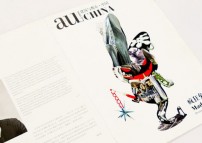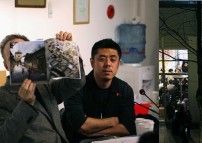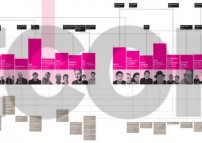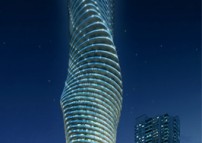ICON magazine published a special edition about MAD’s ongoing projects. Inside, Ma Yansong talks with Douglas Murphy about nearing the completion of the Absolute Towers, being the first Chinese architect to win a major international competition, and what it means to represent a generation.
FULL ARTICLE PUBLISHED AS BELOW:
It's a MAD world
WORDS: Douglas Murphy
PORTRAIT: Joe McCorry
Ma Yansong shot to fame when he became the first Chinese architect to win a major international competition. Now, with those winning rowers approaching completion, he reflects on what it means to represent a country and a generation - and keep from becoming stale.
In many ways, Ma Yansong is a perfect symbol for the current period in architecture. Building massive projects all across the globe, he presides over MAD, a studio of young talent culled from elite architecture institutions and practices around the world.
Intensely comfortable with navigating the high-speed media landscape of eye-catching forms, glossy renders and design blogs, MAD's success has been swift, and symbolic. After completing a year at Zaha Hadid Architects and setting up his own studio, in 2005 MAD won the competition to design the Absolute Towers in Mississauga, near Toronto. Canada, the first major international competition win for a Chinese architect. It was perhaps this aspect of the project that sent the media into overdrive, imbuing the scheme and Ma Yansong himself with the unenviable task of representing a generational shift in global culture. Now, five years on, is he doomed to stay trapped within this narrative, or can MAD ride out this wave of hype to become a fixture of the architectural establishment?
"I do fee l pressure. But this pressure is from myself. I don't feel pressure from others," says Ma Yansong, sipping green tea in the lounge of a boutique hotel in West London. He's briefly in town to be awarded a RIBA International Fellowship, an award that he discusses with what soon becomes clear is a typical air of quiet bemusement: "It was a surprise for me because I'm not a member of an architectural association even in China! In my memory, RIBA is very serious and a fellowship is for people who have already built a lot of successful buildings. We are such a young office ...” In conversation he's quiet, thoughtful, even slightly self-deprecating. But it's clear that there's serious confidence and ambition at work as well. He's certainly more than aware of the investments that are being made in him. "I think they are trying to encourage young offices like us, especially from China. I look back at our six years and I feel that our office is very tightly related to the development of the country."
But what defines a MAD project? In truth it has built little, although numerous buildings are on site. The Absolute Towers are perhaps the best example of the last decade's vogue for twisted towers, their curvaceous forms encouraging the inevitable puerile nickname of "Marilyn Monroe". Another project on site is the Sinosteel International Plaza, a more directly orthogonal tower with a delicate moire facade created by varying the size of the window apertures. The Fake Hills apartments are a gigantic (half a million square metre) slab-block with a silhouette mimicking a series of rolling mountains while the Erdos museum in inner Mongolia is a wobbling blob, reminiscent equally of Peter Cook and Buckminster Fuller. MAD buildings are, in general, formally expressive, often indebted to Zaha Hadid, but they don't have the consistency of design language that you might find in her work or in that of other young global architects like BIG. In fact they seem to draw liberally from various sources a magpie aesthetic of different contemporary styles. "I think there are two ways to do architecture," says Ma. "One is that you have your own methodology or theory, something that can be developed, that everyone can use and understand. Emotion is something that is maybe not reasonable; not explainable; nobody can repeat it twice. not even yourself. I don't think style is a good thing when you repeat yourself. I'm also not very rational. I cannot discover some methodology I can repeat."
It seems strange to be listening to an architect discussing feelings - they are usually far more comfortable justifying their work in theoretical terms, and it's worth noting that Ma has worked with two prime theorists of architecture, first Peter Eisenman, then Patrik Schumacher at Zaha Hadid. But the subjective response is a consistent theme as Ma discusses his work. One that perhaps marks a genuine difference in sensibility: "The emotional part of the buildings that comes at people in a spiritual level- that's architecture," he says. "When I was starting in China I built tighter relationships with contemporary artists than architects. I think artists like us more than architects! When they talk, it's more about personal thinking - what you believe, what you think. With architects it's different."
This fellow-feeling has led to Ma producing artworks throughout his career. For example Ink Ice (2006) was a sculpture made from blocks of frozen ink which slowly melted over three days, first revealing a strange geology of dissolving form, then a stain and finally nothing. More recently were the friendly dinosaur footprint playgrounds for the 2009 Shenzhen Biennale and the collaboration with Olafur Eliasson. Feelings are Facts (2010). A fogged interior suffused with coloured light. On the one hand Ma's enjoyment of more artistic work seems to stem from the familiar desire of architects to be freed from cynical clients and their constraints. But on the other it helps to make sense of some of the social ideas and motives underlying MAD's architectural projects. Such as Beijing 2050 a proposal that included the Hutong Bubble (Icon 077). A gentle critique of comprehensive redevelopment, and the sly yet weighted idea to turn Tiananmen Square into an urban forest.
Ma sees this social engagement less as a European notion of "criticism", and more as a spiritual question: "I like the sensitive part of artists. I think they have a tighter relationship with our society and that's important to me also."
MAD may have a different approach to the previous generation. But it is recognisably close to a number of other young architects. In the last few years, the route to world domination has been to spend a few years working at a "starchitect" before winning a competition and setting up alone. In this milieu are architects such as Bjarke Ingels (BIG. Icon 079). Julien de Smedt UDS). Joshua Prince-Ramus (REX) and Fernando Romero (LAR). All of whom came through the ranks at OMA (and share its predilection towards threeletter acronymic titles).
In 2008, MAD curated a conceptual masterplan for Huaxi City in China which was a veritable "who's who" of this generation, Including the forementioned architects as well as Mass-Studies, Serie (page 068) Sou Fujimoto and others. The resulting cacophony of designs showed the current dominance of a rampant individualism. But also that all of these architects have formal and organisational preoccupations with malformed towers, or massive low landscape buildings covering large sites. Does Ma feel close to his peers investigating similar Themes? "We very often exchange ideas and learn from each other. So we're familiar with each other what we're doing, the state of each other's projects. On the other hand, we have to be very independent. I think it's not like before, like modernism - they all had the same goal for architecture." One major difference is that where his fellows have a reputation for never saying no, Ma is more careful about the road that MAD takes: "I think that last year we were very low-key. We didn't publish" anything; we almost refused all the interviews. We also turned down new projects every week."
Underneath all the media savviness, Ma remains wary of hype: "I cannot adopt the term 'successful young architects' - I don't think that exists. So now we define 'successful’ because you're published, you have an image, you're popular or you can get a big project, but you don't have to be a good architect to be successful in that way. I think communication success is one thing, but successful architecture is another."
So what does Ma Yansong want to achieve? What is the future for MAD? In recent years I have been very interested in traditional gardens, and I have been working on a way to connect people and nature through architecture." This can be seen in the Hutong Bubble, or the Huangdu Art Centre (2008), a project consisting of a conglomeration of quasi-traditional courtyards and trees. Or take the Urban Forest. a 400m tower in Chongqing covered in foliage, perhaps the most prominent example of MAD's attempts to reconcile nature with super high density_ "I don't see this building as a green building or sustainable architecture," says Ma. Rather. It is an example of his "spiritual" attitude oriented equally to the past and the future. "I think in traditional architecture people feel nature in a very emotional way. They don't judge those buildings by numbers." It is certainly possible to read Ma's interest in nature and spirit as the development of something specifically Chinese about MAD's architecture. But perhaps as glib a connection as this puts undue pressure on MAD to represent the historical forces that have brought him to prominence. “I think these feelings are stronger when I am in China," admits Ma. "When we did the Toronto project, they mentioned that I am an architect from China. But nobody asked why there would be a Chinese architecture. I think in the end. Chinese architecture won't have a strong identity. Simply because Chinese people don't like to agree with each other'" He laughs. "It's so big with different cultures and different backgrounds, nobody will agree. I think that's a very healthy situation."
For more project information, please see MAD works - Absolute Towers
 2013-09-28Ma Yansong won the first China Architecture Design in 21st AWARD
2013-09-28Ma Yansong won the first China Architecture Design in 21st AWARD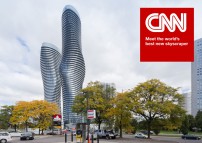 2013-09-22Absolute Tower is awarded as the world’s best new skyscraper
2013-09-22Absolute Tower is awarded as the world’s best new skyscraper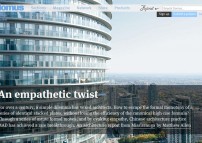 2012-11-09Completed Absolute Towers reviewed by DOMUS
2012-11-09Completed Absolute Towers reviewed by DOMUS
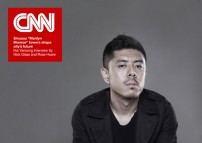 2012-09-27CNN Interviews Ma Yansong
2012-09-27CNN Interviews Ma Yansong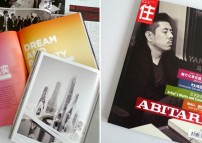 2012-08-05Abitare special issue: Being Ma Yansong
2012-08-05Abitare special issue: Being Ma Yansong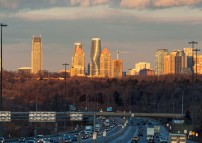 2012-06-14MAD wins CTBUH award for Absolute Towers
2012-06-14MAD wins CTBUH award for Absolute Towers
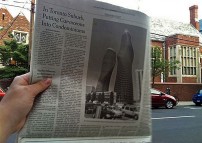 2011-07-20Absolute Towers featured In the NEW YORK TIMES
2011-07-20Absolute Towers featured In the NEW YORK TIMES 2011-03-17Ma Yansong interviewed by Financial Times on “Conquering the west”
2011-03-17Ma Yansong interviewed by Financial Times on “Conquering the west”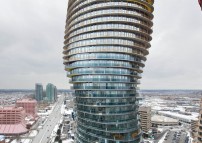 2010-11-25Absolute Towers Top Sealed
2010-11-25Absolute Towers Top Sealed

